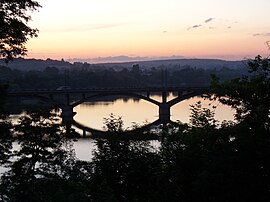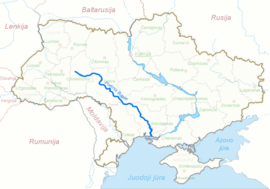geo.wikisort.org - River
The Southern Bug, also called Southern Buh[1] (Ukrainian: Південний Буг, Pivdennyi Buh; Russian: Южный Буг, Yuzhny Bug; Romanian: Bugul de Sud or just Bug),[1] and sometimes Boh River (Ukrainian: Бог, Polish: Boh),[2] is a navigable river located in Ukraine. It is the second-longest river in Ukraine.
| Southern Bug Ukrainian: Південний Буг, Pivdennyi Buh | |
|---|---|
 Southern Bug River in the vicinity of Vinnytsia, Ukraine | |
 Southern Bug through Ukraine | |
| Location | |
| Country | Ukraine |
| Physical characteristics | |
| Source | |
| • location | Khmelnytskyi Oblast, Ukraine |
| Mouth | |
• location | Bug Estuary, Ukraine |
| Length | 806 km (501 mi) |
| Basin size | 63,700 km2 (24,600 sq mi) |
| Discharge | |
| • average | 108 m3/s |
| Basin features | |
| Progression | Dnieper–Bug estuary→ Black Sea |
![The river is named as Bog Fl[uss] on this German map.](http://upload.wikimedia.org/wikipedia/commons/thumb/f/f7/Yedisan.jpg/220px-Yedisan.jpg)
The source of the river is in the west of Ukraine, in the Volyn-Podillia Upland, about 145 kilometres (90 miles) from the Polish border, from where it flows southeasterly into the Bug Estuary (Black Sea basin) through the southern steppes. It is 806 kilometres (501 miles) long and drains 63,700 square kilometres (24,600 sq mi).[3]
Several regionally important cities and towns in Ukraine are located on the Southern Bug. Beginning in Western Ukraine and moving downstream, in a southeasterly direction, they are: Khmelnytskyi, Khmilnyk, Vinnytsia, Haivoron, Pervomaisk, Voznesensk and Mykolaiv.[3]
Between 1941 and 1944 during World War II the Southern Bug formed the border between the German-occupied Ukraine and the Romanian-occupied part of Ukraine, called Transnistria.
Nomenclature, etymology and history
(Ukrainian: Південний Буг, Pivdennyi Buh; Polish: Boh; Russian: Южный Буг; Ottoman Turkish: Aksu)
Herodotus (c. 484–425 BCE) refers to the river using its ancient Greek name: Hypanis.[4] During the Migration Period of the 5th to the 8th centuries CE the Southern Bug represented a major obstacle to all the migrating peoples in the area.
The long-standing local Slavic name of the river, Boh (Cyrillic: Бог),[2] according to Zbigniew Gołąb as *bugъ/*buga derives from Indo-European verbal root *bheug- (having cognates in old Germanic word *bheugh- etc. with meaning of "bend, turn, moves away"), with hypothetical original meaning of "pertaining to a (river) bend", and derivatives in Russian búga ("low banks of a river, overgrown with bushes"), Polish bugaj ("bushes or woods in a river valley or on a steep river bank"), Latvian bauga ("marshy place by a river").[5] The 17th-century French military engineer and geographer Guillaume Le Vasseur de Beauplan recorded the name of the river as Bog.[6]
From the 16th to the 18th centuries most of the south of Ukraine was under Turkish imperial domination and the colonists renamed the river using their own language to the Aq-su, meaning the "White river". Indigenous Slavic toponyms were re-established after the liberation of the Pontic region from Turkish domination in the 17th and 18th centuries.
On March 6, 1918, the Central Council of the Ukrainian People's Republic adopted a law on the "administrative-territorial division of Ukraine", dividing it into regional districts. One of these, Pobozhia (meaning lands of the Boh, Ukrainian: Побожжя), was in the upstream lands of the Southern Bug, near the source of the river.
Tributaries
The main tributaries of the Southern Bug are, from source to mouth (length in parentheses):
- Left: Buzhok (75), Ikva (57), Snyvoda (58), Desna (80), Sob (115), Udych (56), Synytsia (78), Synyukha (111), Velyka Korabelna (45), Mertvovid (114), Hnylyi Yelanets (103), Inhul (354)
- Right: Vovk (71), Zghar (95), Riv (104), Silnytsia (67), Dokhna (68), Savran (97), Kodyma (149), Bakshala (57), Chychyklia (156)
Ecology
In October 2020, the Southern Bug was stocked with three hundred and fifty kilograms of Hungarian carp and 50 kilograms of silver carp at Khmelnytskyi.[7]
Bridges and ferries

The Varvarivskyi Bridge over Southern Bug in Mykolayiv is a swing bridge (facilitating ship building) with Europe's largest span (134 m).[8] It is also the southernmost bridge over the river.
Navigation
The river is technically navigable for dozens of kilometers up from its mouth; several riverports (such as Mykolayiv) exist.
In 2011, plans were announced to revive commercial freight navigation on the Southern Bug upstream of Mykolayiv, to facilitate the increasing grain export from Ukraine.[9] As of April 2018, freight navigation was renewed between the estuary and a newly built grain terminal in the village of Prybuzhany, Voznesensk Raion, in the centre the Mykolaiv Oblast.
Gallery
- Winter-frozen Southern Bug in Mykolaiv.
- The Ploska River emptying into the Southern Bug.
- Southern Bug in Vinnytsia.
- A riverboat on the river in Vinnytsia (2006).
- Riverside skyline of Khmelnytskyi.
- Southern Bug in vicinity of the Granite-steppe lands of Bug landscape park.
- Southern Bug in Medzhybizh
References
- "Encyclopædia Britannica: Southern Buh (River)". Encyclopædia Britannica. Retrieved May 8, 2011.
- Boh River at the Encyclopedia of Ukraine
- Южный Буг, Great Soviet Encyclopedia
- Herodotus (2009-01-30). The Histories. p. 165. ISBN 9781596258778. Retrieved 2013-01-05.
- Gołąb, Zbigniew (1992), The Origins of the Slavs: A Linguist's View, Columbus: Slavica, pp. 258–260, ISBN 9780893572310
-
Le Vasseur de Beauplan, Guillaume (1651). Golitsyn, Avgustin Petrovich (ed.). Description de l'Vkranie depvis les confins de la Moscovie jvsqu'avx limites de la Transylvanie [Description of the Ukraine from the borders of Muscovy to the limits of Transylvania]. Bibliothèque russienne (in French). Paris: J. Techener (published 1861). p. 57. Retrieved 2014-10-30.
A trois lieues audessus de Douczakow [Ochakiv] est l'emboucheure du Bog où se trouve vne isle en forme de triangle, viron de demi lieue de long le trauers de Semenwiruk. [...] Au dessus de Semenwirut, il y a sur le Bog Winaradnakricza, qui est vne fontaine sur un précipice, lieu beau et propre à habiter, tant pour le bois qui est à commodité que pour les moulins qui s'y pourraient faire.
- "У Південний Буг запустили 350 кілограмів угорського коропа". khmelnytskyi.name (in Ukrainian). Retrieved 2020-10-26.
- "History". Kyivdiprotrans Institute. Archived from the original on 30 December 2013. Retrieved 19 August 2013.
- «НИБУЛОН» заложил основу собственного флота(in Ukrainian)
External links
- Southern Buh rafting
- (in Polish) Boh in the Geographical Dictionary of the Kingdom of Poland (1880)
- (in Russian) Photos of the Southern Buh coasts
- (in Russian) Southern Buh rafting, photo
На других языках
[de] Südlicher Bug
Der Südliche Bug (ukrainisch Південний Буг .mw-parser-output .Latn{font-family:"Akzidenz Grotesk","Arial","Avant Garde Gothic","Calibri","Futura","Geneva","Gill Sans","Helvetica","Lucida Grande","Lucida Sans Unicode","Lucida Grande","Stone Sans","Tahoma","Trebuchet","Univers","Verdana"}Piwdenny Buh, polnisch Boh, russisch Южный Буг Juschni Bug, im Altertum Hypanis) ist ein 857 km langer Fluss in der Osteuropäischen Ebene in der südwestlichen Ukraine. Er sollte nicht mit einem anderen Fluss, dem Bug an der Ostgrenze Polens, verwechselt werden. Bis zur Einmündung in den gemeinsam mit dem Dnepr gebildeten Dnepr-Bug-Liman ist er 806 km lang. Das Einzugsgebiet des Südlichen Bug hat eine Fläche von 63.740 km².- [en] Southern Bug
[es] Bug Meridional
El Bug Meridional, o simplemente Bug,[1] también llamado Buh o Bog (en ucraniano, Південний Буг, Pivdennyi Buh, que corresponde al antiguo Hipanis en griego clásico), es un importante río de Europa oriental. Nace en los altos de Podolia, a unos 145 km de la frontera polaco-ucraniana y discurre hacia el sureste hasta desembocar en el mar Negro. Su longitud es de 806 km, y drena una cuenca hidrográfica de 63 700 km².[it] Bug Orientale
Il Bug Orientale anche detto Bug Meridionale[1] (in ucraino: Південний Буг?, traslitterato: Pivdennyj Buh; in russo: Южный Буг?, traslitterato: Južnyj Bug; in greco antico: Hypanis), talvolta traslitterato Buh, è un fiume lungo 857 km che scorre nella parte sudoccidentale dell'Ucraina.[ru] Южный Буг
Ю́жный Буг (укр. Півде́нний Буг) — река на юго-западе Украины; в пределах Хмельницкой (122 км), Винницкой (324 км), Кировоградской (70 км) и Одесской (40 км; по границе с Кировоградской), а также в Николаевской (250 км) областях. Длина — 806 (до лимана 792—806) км, площадь водосборного бассейна — 63 700 км². Уклон реки — 0,4 м/км[1].Другой контент может иметь иную лицензию. Перед использованием материалов сайта WikiSort.org внимательно изучите правила лицензирования конкретных элементов наполнения сайта.
WikiSort.org - проект по пересортировке и дополнению контента Википедии

![The Ploska River [uk] emptying into the Southern Bug.](http://upload.wikimedia.org/wikipedia/commons/thumb/2/27/Rika_Ploska_vpadaye_v_Pivdenny_Bug%2C_Khmelnitsky%2C_2005_07_28.jpg/120px-Rika_Ploska_vpadaye_v_Pivdenny_Bug%2C_Khmelnitsky%2C_2005_07_28.jpg)




